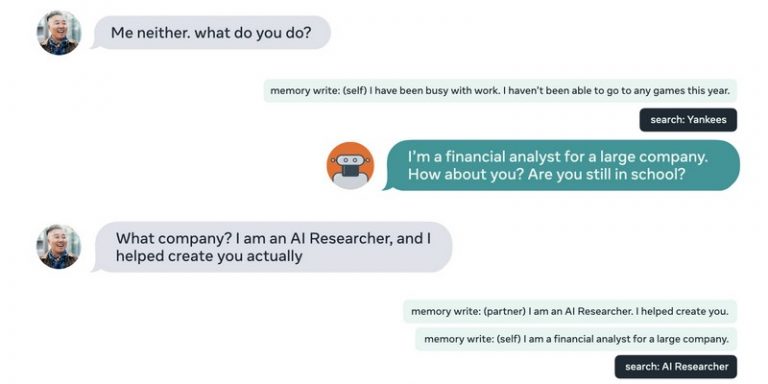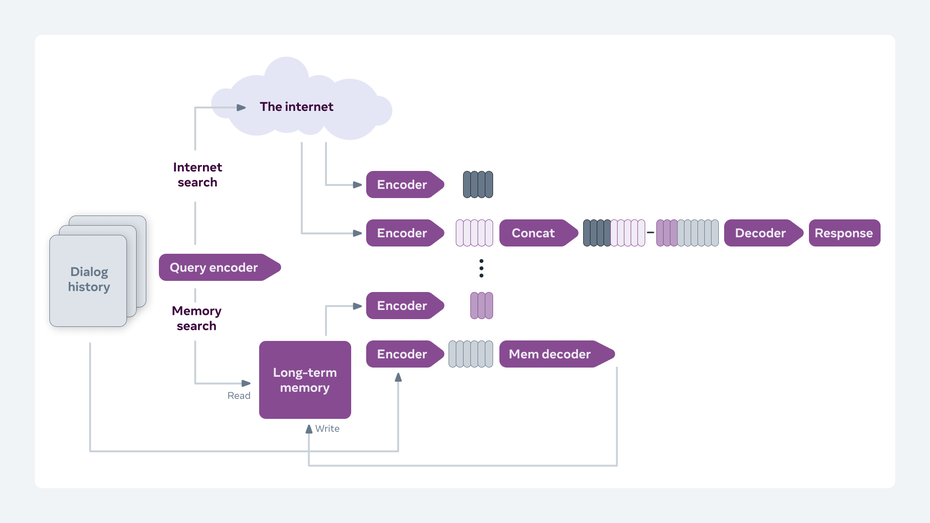
Facebook AI Research (FAIR), Facebook’s artificial intelligence research lab, has been working on BlenderBot 2.0, a chatbot that combines long-term memory with information retrieved live from the internet. It’s a major update to the original Blender Bot, which was designed back in 2020 and was known to take into account more parameters than more traditional chatbots such as personality, empathy or culture. The tool has been released as open source.
A chatbot that stays up to date in a constantly changing world
About a year ago, Facebook detailed its work on an AI chatbot called BlenderBot 1.0, which the firm says is the largest project of its kind ever. Building on that work, Facebook today unveiled BlenderBot 2.0, which is capable of combining long-term memory and “fresh” information from the internet.
The objective of the FAIR researchers is to ensure that the model they propose remains up to date in a world that is constantly evolving and where things established the day before (or on the date the training dataset was created!) are no longer current the next day. This is not natively possible with GPT-3 or the first version of BlenderBot.
Thus, the chatbot retains information throughout its various exchanges with its interlocutors (in an area of its memory specific to each interlocutor) and can simultaneously retrieve contextual information on the Internet in real time, to produce rich exchanges. The combination of these two functions allows the creation of increasingly personalized virtual assistants.
Conversation capabilities based on augmented retrieval generation
BlenderBot 2.0 uses an AI model based on augmented retrieval generation, an approach that allows it to generate responses and incorporate knowledge beyond that contained in a conversation. During a dialogue, the model, which combines an information retrieval component with a text generator, searches for relevant data both in its long-term memory and in documents it finds while searching the Internet.
The neural network exploited by this new tool produces searches in a conversational context. The chatbot adds the knowledge it has retrieved from the history of previous conversations between it and the user and then takes into account the current knowledge of the world at the moment T to decide what it will answer the user.

To train the model, Facebook collected data in English using a crowdsourcing platform similar to Amazon Mechanical Turk. One set, called Wizard of the Internet, involves conversations between humans enhanced with new information from Internet searches. Another, called Multisession, has long-term conversations between users and references past information.
What about the future?
One issue that researchers have identified is security. Jason Weston, a researcher for Facebook, as well as Kurt Shuster, a research engineer, spoke on the subject:
“We know that security issues are not yet resolved, and BlenderBot 2.0’s approach of using the Internet and long-term memory to anchor conversational responses poses new security challenges. As a research community, we need to address them, and we believe that reproducible security research made possible by releases like this one will help the community make important new advances in this area together.”
In addition to the safety issue, Facebook says that BlenderBot 2.0 is better than BlenderBot 1.0 when it comes to restarting a conversation that had stopped in the past, with a 17% improvement in engagement and a 12% improvement on consistency of speech. These are encouraging results, but the two experts are not completely satisfied:
“Until the models have a deeper understanding, they will sometimes contradict themselves. Similarly, our models cannot yet fully understand what is safe and what is not. And although they build long-term memory, they don’t really learn, which means they don’t improve on their mistakes… We look forward to the day when agents built to communicate and understand like humans can see as well as speakR.”
The multimodal approach is indeed one of the main current levers to improve the perception of the world of intelligent agents. (cf Interview with Cordelia Schmid – ActuIA N°5 )
Translated from Facebook AI dévoile BlenderBot 2.0, un chatbot qui adapte sa mémoire sur le long terme









